- CRANCELIN
- See ‘crown of rue’.
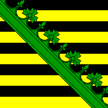
Royal Standard of the
Kingdom of Saxony 1815–1918 (fotw)
- CRAVAT
- 1)A decorative scarf, usually in national or livery colours and often richly decorated,
generally tied with a bow to the staff below the finial, normally (but by no means exclusively)
used with military flags and sometimes displayed with a cockade (see also
‘cockade 1)’, ‘cord(s)
1)’,
‘draping’,
‘finial’,
‘livery colours’,
‘national colours 2)’ and
‘staff 2)’).
- 2) Long black ribbons tied to the staff of a military colour below the finial
to signify mourning by the regiment or unit concerned for the loss of members
of that regiment, or when participating in a military or state funeral - but see
‘draping’.

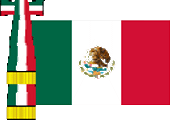
Presidential Standard, France 1940 – 1943 (fotw & CS); National Flag of Mexico (fotw)
Please note with regard to 1) that in French military usage, and possibly
in others, the cravat is employed (including use with car flags) to differentiate
between ranks and functions (see also ‘fanion 3)’,
‘jack of honour’, ‘lanyard 1)’ and ‘lanyard pennant’.
- CRENELLATED
- In vexillology, a term that is sometimes used to describe the battlements of a tower,
castle or wall in place of its heraldic equivalents – see
‘embattled’.
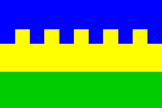
Flag of Triemen, The Netherlands (fotw)
- CRENELLED
- See ‘embattled’.
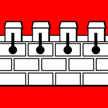
Flag of Wegenstetten, Switzerland (fotw)
- CRESCENT
- 1) In vexillology, a charge in the shape of a crescent moon formed by two interlinked
circles of varying size, generally (but not invariably) shown with the open horns towards
the fly. The crescent is often (but by no means invariably) considered to be symbolic of Islam
- a quarter-moon (see also
‘disc’ and
‘waning or waxing moon’).
- 2) In heraldry a charge in the form of a crescent moon whose horns unless otherwise
specified point upwards – but see ‘moon 2)’ with following notes,
and the note below (also ‘lunel’).
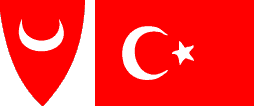
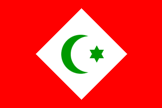
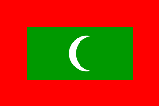
From left: Arms (CS); The National Flag of Turkey (fotw); Flag of
Er Rif 1920 – 1926 (fotw); National Flag of
The
Maldives (fotw)
Please note with regard to 2) that a crescent whose horns point
downward may be termed inverted or reversed – see ‘reversed 2)’.

Flag of
Odèn, Spain (fotw)
- CREST
- 1) The heraldic term for a symbol that is usually (but not invariably)
attached to the helm, is almost always set above a torse and generally
ensigned over the shield (see also ‘Appendix IV’,
‘armorial bearings’,
‘coat of arms’,
‘ensigned’,
‘helm’,
‘shield’ and
‘wreath 2)’).
- 2) See ‘ship’s crest’.
- 3) See ‘military crest’.
- 4) The term is sometimes used to describe a shield or set of armorial bearing – but see note below.
Please note that the term crest should only be used
as specifically defined defined in 1), 2) and 3) above, and should not be considered as a synonym for a coat of arms or set
of armorial bearings (see also
‘armorial bearings’ and
‘coat of arms’).
- CREW’S MEAL PENNANT
- See ‘meal pennant’.
![[crew's meal pennant]](../images/v/vxt-d1193.gif)
Crew’s Meal Pennant, US (fotw)
-
- CROATIAN WATTLE
- See ‘wattle(d) 1)’
![[Croatian wattle]](../images/v/vxt-d1788.gif)
Flag of Ustasha Youth 1941 - 1945, Croatia (fotw)
-
- CROWN
- A ceremonial headpiece in the shape of a circlet often made of precious metal
and usually adorned with pearls and gemstones – see note below (also
‘antique crown’,
‘coronet 1)’,
‘coronet 2)’ and
‘ensigned’,
‘orb’ and
‘sceptre’).
![[crown]](../images/v/vxt-d1567.gif)
![[crown]](../images/v/vxt-d1568.gif)
![[crown]](../images/v/vxt-d105a.gif)
![[crown]](../images/v/vxt-d105.gif)
Royal Crowns, Denmark & Spain (fotw); Tudor Crown 1901 – 1953, St Edward’s Crown (Current Pattern) UK (Martin Grieve)
Notes
a) On flags a crown with a curved
bar or bars across the top and a cap within generally (but not invariably) signifies
a reigning monarch, however, the actual design will usually be specific
to a given country and considerable variations exist.
b)
In
heraldry the term crown has a far wider use, and whilst a few of the many types
encountered are described in this dictionary, it is strongly suggested that a
specialist glossary or dictionary of heraldry be consulted for full details.
- CROWN COLOURS (or COLORS)
- A translation of the Spanish term Banderas Coronelas and referring to a Queen’s, King’s or Imperial Colour - see
‘colour 2)’ and ‘colours 2)’.
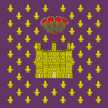
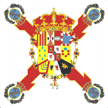
Crown/King’s Colour of the Royal Infantry Guard 1794, Spain (fotw); Crown/Queen’s Colour of the Regiment of Chasseurs Isabel II 1841-1844, Spain (fotw)
- CROWNED
- See ‘ensigned’.

Lesser Arms of Luxembourg (fotw)
- CROWN OF ARMS
- A newly introduced term – and a translation of the German Wappenkrone - that may be used to describe the type of crown which is created from a series related arms, and possibly inspired by the
pavisade – see ‘pavisade’ (also
‘coat of arms 2)’,
‘hamburgian coronet’,
‘leafy crown’,
‘mural crown 1)’ and
‘provincial crown 2)’.


Middle Arms of Baden-Württemberg, Germany (Klaus-Michael Schneider);
National Arms of Croatia (fotw)
- CROWN OF THE HOLY SPIRIT
- In Christian, particularly Iberian tradition, the term for a crown bearing a dove set on its central point (see also ‘marian crown’ and its following note).
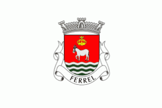

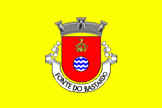

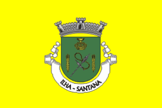
Flag and Arms of
Ferrel, Portugal (fotw); Flag of
Fonte do Bastardo, Portugal (fotw); Arms and Flag of
Ilha, Portugal (fotw)
- CROWN OF RUE
- The heraldic term for a coronet placed in bend – or diagonally – across rather
than above a shield or quarter – a crancelin (see also ‘bend’ in
‘coronet’,
‘in bend’,
‘quarter’ and
‘shield 1)’)


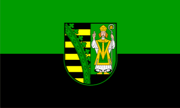

The Flag and Arms of Saxony, Germany (CS); Flag and Arms of Hadeln, Germany (Klaus-Michael Schneider &
Wikipedia)
- CROWN TRIUMPHAL
- The heraldic term for a closed garland or chaplet, usually composed of laurel
leaves, and based on the ancient Roman triumphal ornament (see also
‘civic crown 2)’,
‘decking’,
‘garland’ and
‘wreath of immortelles’).
![[collar]](../images/v/vxt-d107.gif)
(Parker)
- CROZIER
- In some Christian usages the ceremonial staff of a prelate (see also ‘mitre’ and
‘stringed’).


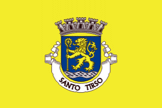

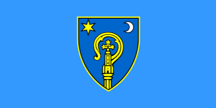
Flag of Basel, Switzerland (fotw); Arms and Flag of
Santo Tirso, Portugal (fotw); Arms and Flag of
Dugo Selo, Croatia (fotw)
- CRUTCH
- A term for the central point at which the two triangles formed by a swallow-tailed
cut in the fly meet (see also ‘orthogonal’,
‘palm’ and
‘swallow-tail(ed)’).
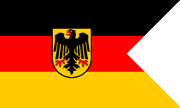
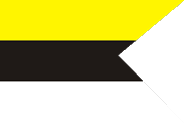
Naval Ensign of Germany (fotw); Flag of
Námestovo, Slovakia (fotw)
- CRUTCH CROSS
- See ‘cross potent’ in ‘Appendix VIII’).
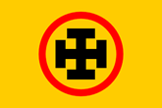
A flag of the Christian Falangist Party, Germany (Tomislav Todorovic)
- CUSTOMS FLAG (ENSIGN, JACK or PENNANT)
- A flag or ensign, different from the national/state flag or government ensign or a pennant, which specifically identifies the installations or vessels
of a country’s customs service (see also ‘national flag’,
‘government ensign’ and ‘service ensign’ under ‘ensign’,
and ‘state flag’).

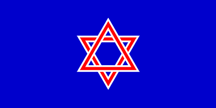

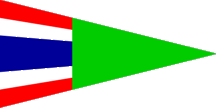
From left: Customs Flags/Jack,
Israel; Customs Flag, Sudan (fotw); Customs Flag,
Japan (fotw); Customs Pennant,
Thailand (fotw)
- CUT-AND-PASTE FLAG
- See ‘friendship flag’.

Canada-US Friendship/Cut-and-Paste Flag (fotw)
- CYBERVEXILLOLOGY (or CYBERVEX)
- Vexillological research and/or the publication of vexillological information
using electronic means, particularly the Internet or other electronic delivery
systems.
- CYPHER
- See ‘royal cypher 1)’ and
‘monogram’.

Cypher of the French Republic (CS)









![[Croatian wattle]](../images/v/vxt-d1788.gif)
![[crown]](../images/v/vxt-d1567.gif)
![[crown]](../images/v/vxt-d1568.gif)
![[crown]](../images/v/vxt-d105a.gif)
![[crown]](../images/v/vxt-d105.gif)




























![[crew's meal pennant]](../images/v/vxt-d1193.gif)
![[collar]](../images/v/vxt-d107.gif)
